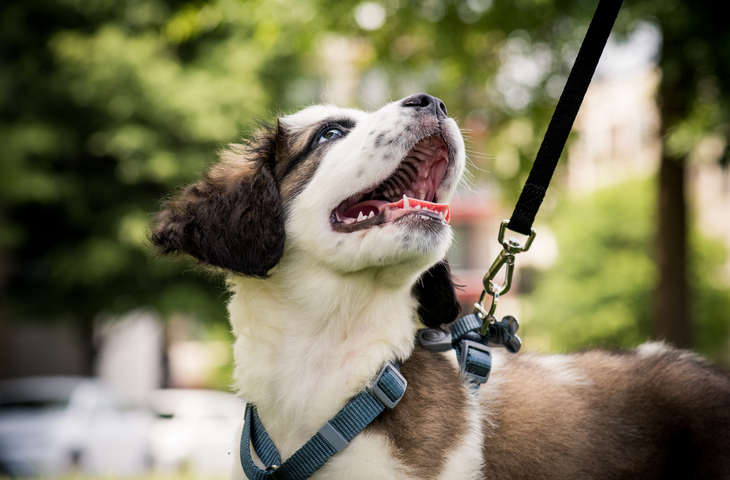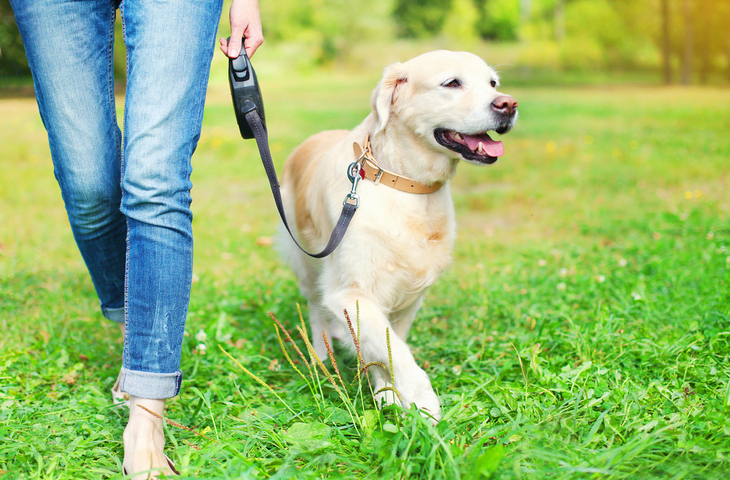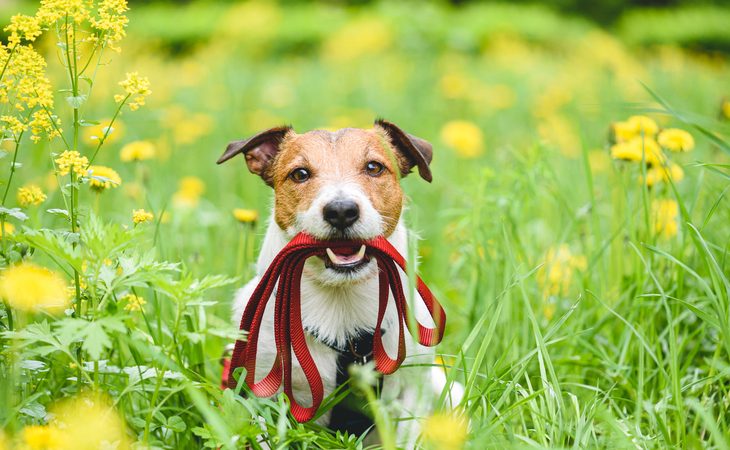My dog pulls on the leash during walks. What solutions are available to me? To help you share a relaxing moment with your dog during walks, we will answer this question. In this article, we will explain why your dog pulls on their leash, the tools and accessories to use and how to teach your dog to walk on their leash without pulling.
My dog keeps pulling on the leash: why?
There are several reasons why dogs might drag you behind them and pull on their leash. Here are a few of the most common reasons.
Your dog learned to pull on their leash during walks with you or others
For a dog to be able to walk on a leash without pulling and match your walking pace, it requires training. Naturally, dogs move faster than humans, so they must learn to slow down. Moreover, your dog has many sources of stimulation outside (other animals, smells, objects, etc.) that they will try to discover or, on the contrary, avoid. This motivates them to pull.
When you walk your dog and they pull and you keep moving forward, you are actually fulfilling their expectations. When they pull, they move forward, allowing them to go towards their goal. This reinforces their behavior.
Your dog has excess energy to burn
Your dog may have difficulty controlling themselves and be unmanageable on a leash because they are overflowing with energy and having trouble channeling it. For example, when your return from a day of work, during which they were left alone, they need to evacuate all the energy that they have accumulated. The best thing to do in this case is to allow your dog to expend their energy before the walk. You can do activities such as search games, educational exercises, etc. This will allow your dog to tire themselves out before the walk.
Your dog is not paying attention to you
Having a strong human-dog bond is important in everyday life, especially when walking with a leash. Your dog may pull on the leash because they don’t want to listen to you, they aren’t interested in you, or don’t pay attention to you during walks. When they are following a scent, they no longer hear you and rush to find what they are smelling. They might also be interested in a dog that is walking in front of them. In this case, you will have to teach your dog to redirect their attention to you and not to what is around them.

Dogs might pull on the leash because they are afraid
The outdoors can be a source of anxiety for your dog. Noises, smells, humans, dogs, and other things can make your dog very uncomfortable. A dog that is afraid is not able to follow you on a walk. All their attention and emotions are focused on the source of their fear and their instincts take over. It is best to progressively teach your dog how to deal with all this when going for a walk. This is a long-term learning process that requires the help of a professional.
My dog keeps pulling on the leash: what tools or accessories can help me?
Are you trying to stop your dog from pulling on the leash? Here are some tips.
Avoid coercive accessories
Choke collars or spike collars, for example, put a lot of pressure on your dog. In addition, these are accessories that can inflict injuries on your pet. Instead, choose a flat collar that is both strong and comfortable.
Invest in a no-pull harness
There are many different types of dog harnesses. The anti-pull harness has an attachment system at the front of the harness, at the chest of the dog. When the dog pulls, the leash connected to this attachment point will turn them to the side, gently breaking their momentum. Different models of anti-pull harnesses are sold in stores. The important thing is that the harness you choose should be gentle on your dog’s joints and not restrict their movements. This type of harness ensures a relaxed walk for you and a pleasant one for your dog. It gives you the ideal conditions to teach your dog to walk on a leash without pulling.
The type of leash
A retractable leash or a long leash is not suitable for teaching your dog to walk on a leash without pulling. Instead, try a stronger and shorter leash (2-3 meters or around 6-10 feet).
Reward your dog
Rewards are an important element when training a dog. It allows the dog to associate something pleasant with an action expected from you. This reinforces the “right” behavior. While petting or a cheerful voice may be enough, treats and/or a favorite toy can be a great help when teaching your dog to walk on a leash.

Teaching your dog to go on walks without pulling on the leash
Accessories and rewards aren’t everything. Your dog also needs to learn how walking on a leash should be done.
Teaching your dog to focus on you
The goal is to keep your dog focused on you and not on their environment when on walks. When out on walks, don’t pay special attention to your dog. While walking, walk quietly. When your dog moves away or in a certain direction, walk in the opposite direction. Repeat this action to encourage your dog to pay attention to your movements and adapt to them by following you. Stay relaxed and your dog’s training should go smoothly.
You can also teach your dog to pay attention to you by rewarding them when their eyes turn to you. If your dog doesn’t do this spontaneously, you can also call them, even when they are on a leash, and then praise them when they look at you.
Teaching your dog not to pull on the leash
When your dog pulls on the leash, your first reflex is to pull back. However, this usually causes your dog to resist and pull even harder. Whenever your dog pulls, stop and stay put. Do not pull on the leash, talk to them, look at them or touch them. Your dog must associate stopping (which is not what they want) with pulling. Walking (their reward) will only resume when the leash is relaxed and they stop pulling.
It may seem like a long time at first. You may even feel like you’re spending more of your time stopping than moving. This is normal. Just be patient. If your dog still pulls despite your fixed position, take a few steps backward and then go for a walk when the leash is relaxed. When you are teaching your dog, always use the same leash or the same length. This is so that your dog adapts not only to your pace but also to the distance available between you and them.
How long does it take for a dog to learn to go on walks without pulling on the leash?
Teaching a dog to walk on a leash without pulling requires patience. In some cases, it can take weeks. When teaching your dog, it’s best to keep the training sessions short. However, be sure to repeat them regularly to ensure success. The environment is also very important in learning. It is best to start in a calm, familiar place to help your dog concentrate better. The increase in difficulty must be gradual. For example, you can start in a calm environment, then continue in a more urban environment such as a park. If all goes well, you can then move to an urban environment with more stimuli.
Lastly, whenever possible, allow your dog to explore the area on their own to let them sniff and run around at their own pace. This will make it easier for your dog to channel their energy when learning how to walk with a leash.

